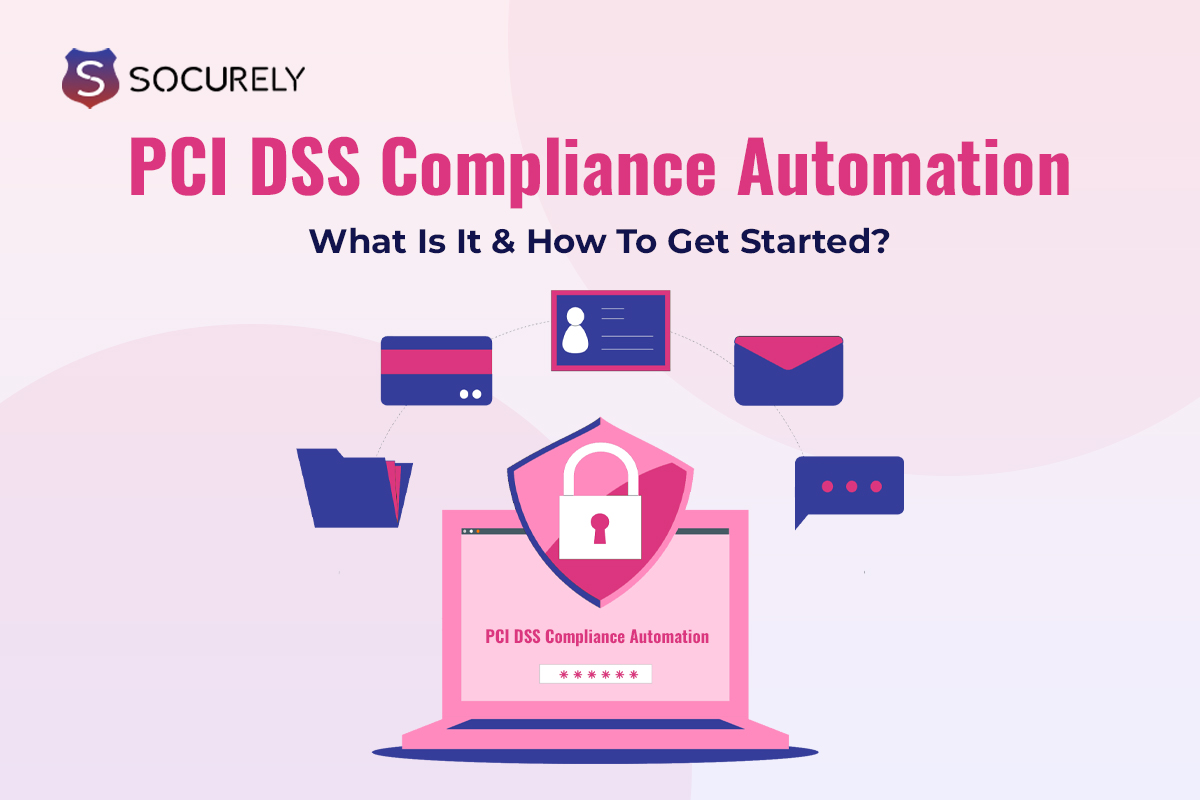Being a business person, we know you did everything to win your customer’s trust. Although, have you ever thought of the modern world threats to your data and payment security? Yes, in the tech-evolving world, focusing on data security and a seamless payment system is not just an option but a necessity.
With cyberattacks on the rise—37% of organizations worldwide have experienced a data breach in the past year—ensuring the security of payment card information has become paramount. Herein lies the importance of PCI DSS (Payment Card Industry Data Security Standard).
Enter PCI DSS compliance automation: a transformative approach that leverages technology to simplify, streamline, and enhance compliance efforts.
In this comprehensive guide, we will elaborate the PCI DSS automation and the myriad benefits it offers.
What Is PCI DSS Automation?
We know that PCI DSS Payment Card Industry Data Security Standard) holds the payment security measures. Also big men like Visa, MasterCard, and American Express created this framework for both small and large businesses. PCI DSS automation refers to the use of advanced software tools and technologies to automate the processes required for achieving and maintaining compliance with the Payment Card Industry Data Security Standard (PCI DSS). Rather than relying on manual processes such as regular assessments, extensive documentation, and periodic reporting, automation allows businesses to continuously monitor, assess, and report on compliance activities in real-time. This not only enhances efficiency but also reduces the likelihood of human error, ensuring that all compliance tasks are performed accurately and consistently.
Some features of Automated PCI DSS Compliance include e-encryption, segmentation, and monitoring. Businesses may handle the tedious and time-consuming activities involved in becoming PCI compliant with its PCI industrial automation, saving hours spent reading over intricate documentation.
**Also read the updates of PCI DSS Compliance!
Why is PCI DSS Automation Important?
For engineering teams to comply with the Payment Card Industry Data Security Standard (PCI DSS), PCI Automation is essential. It may be challenging and time-consuming to stay on top of these standards, which makes it challenging for teams to concentrate on their main goal. Organizations may increase security without sacrificing product innovation by automating PCI operations.
PCI DSS Automation also uses a user-friendly dashboard that allows you to see your whole network environment, providing you with superior visibility into possible weak areas. Also, it guarantees a corrected automated evidence gathering and that you remain in compliance at all times.
How To Automate PCI DSS Implementation In Your Business?
Implementing PCI DSS automation involves several strategic steps to ensure a seamless transition from manual processes to automated systems. Here’s how to get started:
- Assess Your Current Compliance Status: Begin by evaluating your existing compliance efforts. Identify which manual processes are currently in place and determine which of these can be automated to enhance efficiency and accuracy.
- Choose the Right Automation Tools: Selecting the appropriate tools is critical. Look for solutions that offer comprehensive features such as automated risk assessments, continuous monitoring, real-time reporting, and integration capabilities with your existing IT infrastructure.
- Integrate Automation Tools with Existing Systems: Ensure that your chosen automation tools can seamlessly integrate with your current systems and applications. This integration facilitates smooth data flow and consistent monitoring across all platforms.
- Implement Automation Gradually: Start by automating a few key processes before expanding automation to other areas. This phased approach allows your team to adapt to the new tools and workflows without overwhelming them.
- Train Your Team: Provide adequate training to your team members on how to use the automation tools effectively. This ensures that everyone is on the same page and can maximize the benefits of automation.
- Monitor and Review: Regularly monitor the performance of your automation tools and review their effectiveness. Make necessary adjustments to optimize your compliance efforts and address any emerging challenges.
What Are The Benefits Of PCI DSS Compliance Automation?
Automating your PCI DSS compliance offers a multitude of benefits that can significantly enhance your organization’s security and operational efficiency:
- Time Savings: Automation dramatically reduces the time spent on manual compliance tasks, allowing your team to allocate resources to more strategic areas of the business.
- Efficiency: Automating compliance processes significantly reduces the time and effort required to meet PCI DSS requirements, allowing your team to focus on strategic initiatives rather than tedious manual tasks.
- Accuracy: Automated tools ensure that compliance tasks are executed with precision, minimizing the risk of errors that could lead to non-compliance or security vulnerabilities.
- Enhanced Security: Automated tools provide real-time monitoring and instant alerts, enabling swift detection and response to security threats.
- Scalability: As your business grows, automation tools can easily scale to meet increasing compliance demands without the need for additional manual effort.
- Improved Compliance Reporting: Automation facilitates the generation of accurate and detailed compliance reports, simplifying the process of demonstrating compliance to auditors and stakeholders.
- Reduced Costs: By minimizing manual labor and decreasing the risk of non-compliance penalties, automation can lead to significant cost savings over time.
- Consistency and Reliability: Automated processes ensure that compliance tasks are performed consistently and reliably, reducing the risk of oversight and ensuring ongoing adherence to PCI DSS standards.
- Audit Readiness: Automation tools help maintain a state of continuous compliance, making it easier to prepare for and pass external audits.
Get Started Today!
Embarking on the journey of PCI DSS compliance automation can seem overwhelming, but the rewards are well worth the effort. By leveraging the right tools and following a structured approach, you can streamline your compliance processes, enhance your security posture, and ensure continuous adherence to PCI DSS standards. Start by assessing your current compliance status, choosing the appropriate automation tools, and gradually integrating them into your operations. With the right strategy and support, automation can transform your PCI DSS compliance efforts, making them more efficient, accurate, and cost-effective.
Conclusion
In the rapidly evolving realm of cybersecurity, maintaining PCI DSS compliance is not just a regulatory requirement—it’s a fundamental aspect of safeguarding your business and your customers’ sensitive information. PCI DSS automation offers a powerful solution to simplify compliance, reduce risks, and enhance data security. Whether you’re a small business or a large enterprise, automating your PCI DSS processes can lead to significant improvements in efficiency, accuracy, and overall security posture. Embrace PCI DSS automation today and secure your business against the ever-growing landscape of cyber threats.
FAQ
What Is PCI DSS Compliance?
PCI DSS compliance refers to adherence to the Payment Card Industry Data Security Standard, which is a set of security requirements designed to protect cardholder data during and after a financial transaction. Compliance is mandatory for all organizations that process, store, or transmit credit card information.
Do Issuers Need PCI DSS Compliance?
Yes, issuers, including financial institutions that issue credit or debit cards, are required to comply with PCI DSS standards to ensure the security of cardholder data and maintain the integrity of payment transactions.
What Are The Objectives & Aim Of PCI DSS Automation?
The primary objectives of PCI DSS automation are to streamline compliance processes, reduce human error, ensure continuous compliance, and enhance data security by automating routine tasks such as monitoring, reporting, and risk assessments. This automation aims to make compliance more efficient and reliable, enabling organizations to focus on core business activities.
What Businesses Need PCI DSS Compliance?
Any business that handles payment card information must comply with PCI DSS standards. This includes merchants, payment processors, service providers, and any organization involved in storing, processing, or transmitting credit card data. Compliance is required regardless of the size or industry of the business.
What Is The Cost Of PCI DSS?
The cost of PCI DSS compliance varies depending on factors such as the size of the organization, the complexity of its IT infrastructure, and the level of compliance required. Costs can include assessment fees, implementation expenses, and ongoing maintenance costs. While the investment in compliance can be significant, the benefits of enhanced security and reduced risk of data breaches often outweigh the costs.







